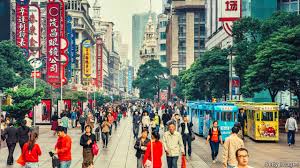Headlines about China’s weak growth are somewhat misleading

AMERICA’S PRESIDENT knows a catchy number when he sees one. Like much of the world’s media, Donald Trump tweeted this week that China’s growth in 2018 was its slowest in nearly three decades. This, he said, ought to compel it to make a “Real Deal” on trade with America. China’s growth of 6.6% last year was indeed the weakest since 1990, and the country does want to end the trade war. But a closer look at the data shows why its leaders are less panicked than Mr Trump might think.
First, the sheer size of its economy means that China’s growth last year generated a record amount of new production. Nominal GDP increased by 8trn yuan ($ 1.2trn), well above the 5.1trn yuan added in 2007, when it notched up 14.2%, its fastest growth in recent decades. The point is simple: China is now growing from a much larger base. But this was overlooked in the flurry of headlines about its slowdown.
The changing nature of China’s growth also provides some cushioning from the trade war. American tariffs are starting to inflict pain: Chinese companies have reported a sharp drop in export orders. But for the broader economy, foreign sales matter less than they used to. Although the falling trade surplus lopped half a percentage point from the growth rate last year, domestic demand more than plugged the shortfall (see chart). Consumption accounted for three-quarters of the growth rate last year, the most since 2000.
Finally, China has made modest progress towards cleaning up its financial system. The government had sought to rein in debt, which had soared over the past decade. Critics have observed that it has failed to bring about any real deleveraging, because debt-to-GDP levels have continued to creep up. But stabilisation, rather than outright deleveraging, was China’s real goal. It has had some success: the pace of debt accumulation has slowed sharply. In 2015 it took more than four yuan of new credit to generate each yuan of incremental GDP. In 2018 that multiple fell to 2.5, in line with China’s average over the past 15 years.
Alongside these positives, however, there were some worrying signs. Nominal growth has slowed significantly, from an annual rate of 11.2% in the third quarter of 2017 to 8.1% in the final quarter of last year. It will slow further this year as inflation decelerates. Since nominal growth is closely correlated with corporate revenue growth, companies could be in for a difficult year.
As for consumption, this year looks less promising than last. Companies have started cutting back hiring and incomes are growing more slowly, weighing on consumer sentiment. The middle three quintiles of China’s population by income distribution saw earnings increase by only about 2% last year in real terms. Those of the richest quintile rose by 6.6%. Given that lower earners tend to spend more of their wages than the rich do, that is a poor basis for sustained growth in consumption. Sales of cars fell last year for the first time in more than two decades. Sales of mobile phones were also sluggish.
China has already pivoted towards more supportive economic policies. It has sped up spending on infrastructure, trimmed income taxes and relaxed some restraints on bank lending. This does not add up to a big stimulus package, but the direction is clear. If growth slows further, as seems likely, the government will move more boldly still.
There is no doubt that China would like to persuade Mr Trump to roll back tariffs on Chinese goods, which would both help its exporters and boost market sentiment. Bilateral talks are grinding on ahead of a March 1st deadline. Chinese negotiators are working on an offer they hope will satisfy their American counterparts, combining pledges to buy more American goods with reforms to treat foreign companies more fairly. But if Mr Trump truly believes what he tweets about the Chinese economy, he is at risk of overestimating the strength of America’s hand. China wants a trade deal, certainly, but it is not desperate.





